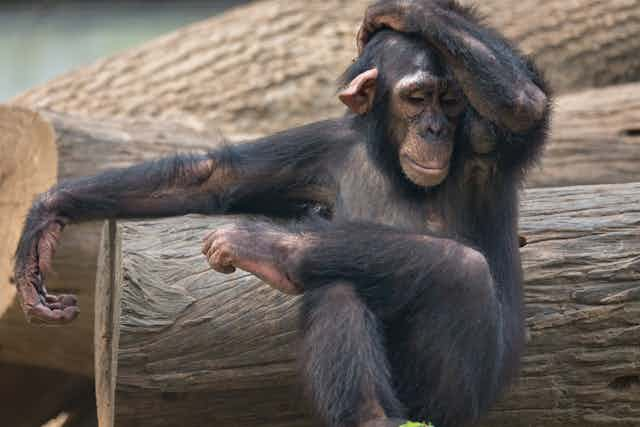How good is your best chimpanzee impression? Go to the zoo and you probably wouldn’t be surprised to see people copying chimps in order to grab their attention. But our latest research, which recently won the Ig Nobel Prize for Anthropology, suggests you are just as likely to see chimpanzees imitating the human visitors.
Established in 1991, the Ig Nobel prizes are granted each autumn to ten unusual scientific discoveries that “first make you laugh, and then make you think.” Our findings unravel a form of imitation as communication that has not been previously reported in non-human apes. We typically think that humans evolved imitation as a way of learning. But our study suggests it can serve several functions, including for other animals.
The research, published in the journal Primates, found that the chimpanzees at Furuvik Zoo in Sweden were just as likely to imitate human visitors as the other way round. We watched a group of five chimpanzees at the zoo and about 10,000 human visitors that stopped by the chimpanzee enclosure. In total, we recorded 1,579 times when a chimpanzee did something directed at a human, and 2,211 human actions aimed at a chimp. About 10% of the actions of each species were imitations.
The actions copied by the humans and chimps were also surprisingly similar, with both favouring hand claps, knocking on the enclosure window, or kissing. This is where things get interesting. Since both species imitated actions they were already highly familiar with, this imitation can’t have been a method of learning but rather appeared to be a way of communicating.
By digging into the data a bit further, we found that interactions that included imitation were longer than those that didn’t. This suggests that imitation was a good way to initiate and maintain social contact between the two species. On several occasions, imitation turned into a game of back-and-forth copying that the chimps seemed to enjoy, making playful facial expressions. This not only shows that the chimpanzees quickly became aware of being imitated by the visitors, but also that they really enjoyed and were interested in the interaction.

Scientists have long agreed that imitation is a key mechanism for social learning that lets humans quickly acquire skills and solutions to problems by copying others. Because it enables knowledge and new inventions to spread and pass down generations, imitation is considered fundamental to our species’ complex culture and advanced technology.
Decades of research shows that, in spite of their proverbial aping abilities, nonhuman apes are rather poor at imitating the actions of others. In experiments where they have to learn a new procedure for solving a problem by watching it being demonstrated, apes systematically perform worse than human children. This might be because they lack the “social side” of imitation, meaning they don’t seem motivated to engage with others by sharing goals and experiences.
In contrast, human children show this social motivation by often gazing at the researcher’s face or smiling during such tasks. They also over-imitate, slavishly copying all the actions performed by a demonstrator, regardless of how relevant they are for solving the task. Apes, on the other hand, appear mostly motivated to acquire the food reward that comes with solving a problem, and so don’t show these “social-communicative” behaviours.
Social imitation
But the social side of imitation extends beyond learning tasks. We also see it when we empathise with others. We smile when they smile, we look sad when they are sad, or yawn when they yawn – and we do this pervasively, yet without awareness or intent. Research shows that our species shares this unintentional kind of social imitation with our closest genetic relatives (chimpanzees, bonobos, and orangutans), and even with non-primate species, such as wolves or sheep.
Another – intentional – kind of social imitation is found in toddlers’ interactions with each other and with adults. Before they master language, toddlers often playfully imitate familiar actions as a way to engage and communicate with others. This is similar to the imitation games we saw at the zoo between chimpanzees and human visitors.
Our study shows that chimpanzees and humans were equally likely to use imitation as a way to interact with each other. Given that we know chimps aren’t as good as humans at learning through imitation, this challenges traditional theories and suggests imitation may have evolved primarily for social reasons rather than as a means of learning. The images evoked by our study of chimps and humans imitating each other at the zoo might make people smile. But the scientific implications reach all the way back to the common ancestor of humans and chimpanzees, and the role imitation may have played for that mysterious species.

